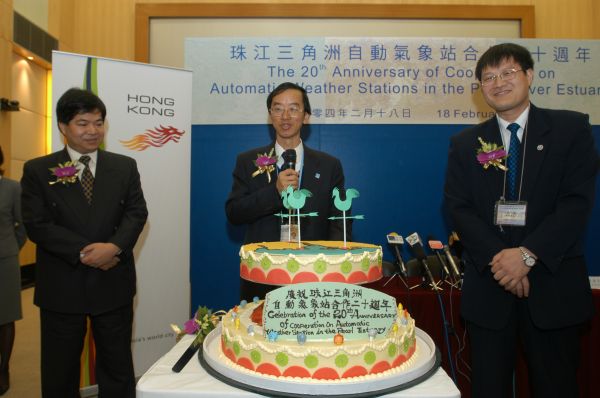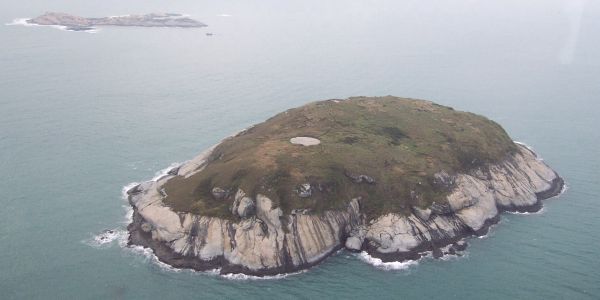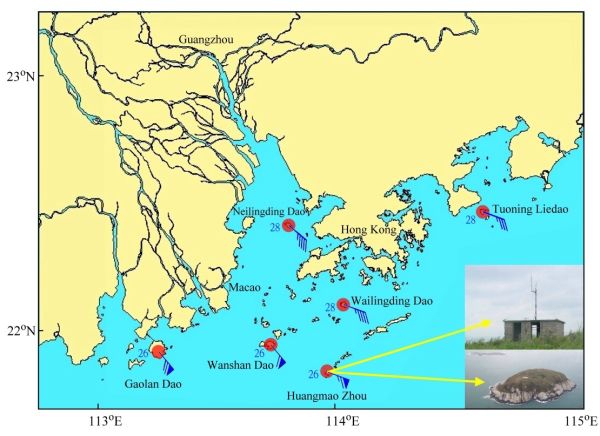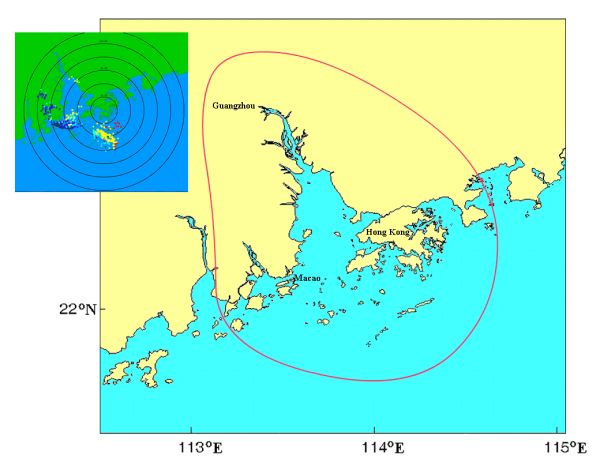Meteorologists celebrate 20 years of teamwork in Pearl River Estuary
Meteorologists celebrate 20 years of teamwork in Pearl River Estuary (18 February 2004)
|
Meteorologists from Guangdong, Hong Kong and Macau today (February 18) marked the 20-year cooperation between the three places in setting up automatic weather stations in the Pearl River Estuary area. In 1984, the Guangdong Meteorological Bureau and the Hong Kong Observatory agreed to cooperate on the establishment of an automatic weather station on the island of Huangmaozhou, 45 kilometres south of Lantau. This marked the start of cooperation on automatic weather stations in the Pearl River Estuary area. During the past 20 years, Guangdong, Hong Kong and Macau jointly established five other automatic weather stations. They are: Tuoning Liedao (1996), Neilingding Dao (1996), Wailingding Dao (1997), Wanshan Dao (1997) and Gaolan Dao (1997). Providing weather information round-the-clock, these stations afford front-line detection and early alerts, of up to a few hours, of weather approaching the Pearl River Estuary from the sea, especially tropical cyclones. Mr Lam Chiu-ying, Director of the Hong Kong Observatory, said: "The cooperation between Guangdong, Hong Kong and Macau on automatic weather stations goes back a long time and is a forerunner of regional co-operation in the Pearl River Estuary area. Through long-term consultation and collaboration among the three places, it has made important contributions to the prevention and mitigation of natural disasters, as well as to the economic development in the area." Energy limitations, due to lack of city power on the islands, posed a major challenge to meteorological workers. Mr Yau Lai-kin, now a Radar Specialist Mechanic at the observatory, was responsible for developing software for the Huangmaozhou weather station 20 years ago. He recalled: "The problem really taxed the capability of observatory colleagues, who succeeded eventually in using solar energy to drive the weather station. However, the electricity generated was still low. We had to resort to the use of a small, low-power microprocessor board having only a 4-kB memory (4,000 bytes), which was several 10,000ths of the memory available in today's personal computers. I was asked to work out under these stringent conditions a small computer program that would carry out all the complex calculations and processes, and succeeded at last after very hard work. Over the years the weather station performed very satisfactorily, requiring just a couple of maintenance trips each year." Apart from the above weather stations, meteorologists from the three places also established over the years the exchange of real-time weather information through dedicated data lines, the networking of weather radar data from the area, and the closer consultation among forecasters in these places during the approach of severe weather. Currently in progress is the expansion of SWIRLS (Short-range Warning of Intense Rainstorms in Localised Systems), developed by the Hong Kong Observatory, to a rainstorm forecasting system covering the Pearl River Estuary. Mr Yu Yong, Director of the Guangdong Meteorological Bureau, said: "Based on the good foundation of co-operation among the three places over the past 20 years, we are confident that with further co-operation, all of us meteorologists in the area will be able to make greater contributions to the prevention and mitigation of natural disasters in the Pearl River Estuary, and will see another fruitful 20 years!" Dr Fong Soi Kun, Director of the Macau Meteorological and Geophysical Bureau, said: "There are already many aspects of meteorological co-operation and technical exchange among the three sides. We hope to further build on the existing co-operation, so as to better serve people in the area." Mr Lam Chiu-ying, Director of the Hong Kong Observatory, further revealed: "The latest development is the collaboration between Guangdong, Hong Kong and Macau on the setting up of a lightning location network covering the Pearl River Estuary." The lightning location network is capable of determining lightning locations within a short time. Mr HT Poon, the observatory's Senior Scientific Officer responsible for the lightning location systems, added: "Our plan is to complete the installation of equipment and launch a lightning location information service next year. We will strive to use the most efficient communication means including the Internet and other channels, to ensure that the public and the relevant business sectors receive the latest lightning information and make the necessary preparations."
|






